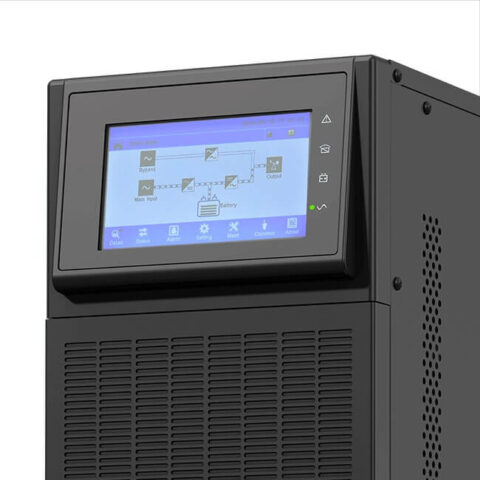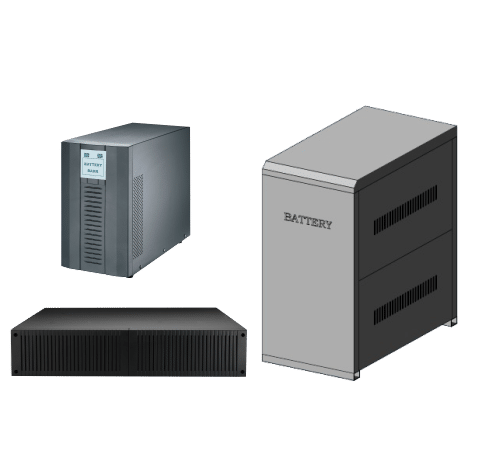Summary
Hot-swappable batteries in UPS systems enable battery replacement or maintenance without interrupting power to connected loads. This design supports higher uptime, safer servicing, and minimal operational disruption, making it beneficial for hospitals, data centres, and tendered projects where continuous availability and ease of field service are non-negotiable.
Introduction
For critical infrastructure tenders (whether in healthcare, local government, or industrial automation), battery replacement can’t mean downtime. That’s where hot-swappable battery architecture becomes non-negotiable. It allows batteries to be removed and replaced without powering down the UPS or transferring load to mains.
Hot-swappability is both a maintenance convenience and a safeguard against costly interruptions in environments that demand continuous availability. Many procurement teams overlook this until a site visit or compliance audit flags the risk. If uninterrupted uptime is part of your operational mandate, your UPS architecture needs to reflect that.
Not sure if your UPS system allows for non-disruptive maintenance? Submit your tender for review.
What Are Hot-Swappable UPS Batteries?
Hot-swappable UPS batteries are designed for non-disruptive replacement. Their configuration allows technicians to change battery modules without powering down the UPS or interrupting supply to connected loads. This is vital for environments where even a momentary outage is unacceptable.
How Do Hot-Swappable Batteries Improve Serviceability?
Hot-swappable battery architecture reduces service-related downtime. Batteries can be replaced during regular operating hours without triggering failover systems or needing scheduled shutdowns. For field teams, it translates to faster maintenance cycles and lower site disruption.
Where Are Hot-Swappable Batteries Required in Tenders?
Tender documents for hospitals, emergency response sites, and mission-critical industrial locations don’t always name “hot-swappability” outright, but the intent is often there. Watch for phrasing like:
- “maintain uptime during servicing”
- “maintenance without load interruption”
- “no interruption during battery replacement”
- “field-replaceable energy modules”
- “battery replacement without system shutdown”
These clauses signal the need for systems where batteries can be replaced without powering down the UPS or load.
What Are the Operational Benefits of Hot-Swappable Batteries?
By enabling live-swaps, these UPS designs:
- Prevent forced downtime during battery servicing
- Support predictive battery maintenance and lifecycle planning
- Reduce emergency service costs and risk
- Improve MTTR (Mean Time To Repair) without compromising SLA commitments
Where Are Hot-Swappable Batteries Used?
Common project types that require or benefit from hot-swappable UPS architecture include:
- Healthcare sites with ICU, labs, or digital imaging reliance
- Water, wastewater and SCADA Systems
- Council-operated emergency response and coordination facilities
- Edge and remote industrial locations
- Transport infrastructure
- Tier III/IV data centres or critical communications hubs
In these scenarios, the cost of shutting down to service a battery outweighs the premium for a hot-swappable solution. Hot-swappability ensures that battery management never becomes a single point of failure in your availability planning. Field serviceability isn’t just operationally beneficial; it can be a compliance issue.
Always cross-check tender language against your product’s maintenance protocols. If your UPS solution involves tools or shutdowns to change batteries, it may fall short of the expected serviceability standard.
What Happens When a UPS Doesn’t Have Hot-Swappable Batteries?
When a UPS doesn’t allow for hot-swappable battery replacement, servicing becomes a high-stakes operation. The system must either be shut down or transferred to a manual bypass, which introduces risk, especially in critical infrastructure where power continuity cannot be compromised.
Can Battery Maintenance Cause Unplanned Downtime?
Yes. Without hot-swappability, routine battery changes often require downtime windows, forcing maintenance to be scheduled after hours or during operational lulls. This adds pressure to support teams and introduces risk if failures occur outside of these windows.
What Are the Compliance Implications in Sensitive Environments?
In healthcare, emergency services, or critical municipal facilities, tender compliance often requires that no single point of failure (including battery maintenance) can interrupt power. Non-hot-swappable designs may fall short of regulatory expectations or jeopardise accreditation audits.
Why Is Manual Bypass an Incomplete Solution?
While manual bypass systems offer a workaround, they are not a true solution. They require trained personnel to engage the bypass safely, and they still pose a risk to connected equipment during the switchover. Hot-swappable designs eliminate this vulnerability entirely.
What’s an Example of Failure Impact?
Consider a hospital ICU relying on ventilators and imaging systems. If a UPS battery must be replaced and the unit lacks hot-swappability, even a brief interruption could endanger patients or corrupt clinical data. This is precisely why such specifications exist in medical tenders.
What UPS Models Support Hot-Swappable Batteries?
Three systems in our portfolio are engineered with hot-swappable architecture. For infrastructure planners and tender consultants, this feature is a non-negotiable requirement tied to continuous availability clauses.
Hot-swappable UPS systems from PSS Distributors:
- 3/1 Phase Modular UPS System: Modular plug-and-play battery modules for rapid replacement in industrial and security installations.
- 3/3 Phase Modular UPS System: High-capacity UPS with parallel operation and hot-swappable modules—ideal for data centres and medical facilities.
- Patriot Modular DC UPS: Rack-mounted rectifier units, hot-swappable and redundant, purpose-built for telecom and utility-grade environments.
Hot-Swappable UPS Comparison Table
| Model | Hot-Swappable Design | Typical Applications | Scalability | Runtime Options |
| 3/1 Phase Modular UPS | Plug-and-play | IT racks, industrial, security | High | EBXL compatible |
| 3/3 Phase Modular UPS | Plug-and-play | Medical, mining, data centres | Very high | EBXL compatible |
| Patriot Modular DC UPS | Rectifier-based | 5G base stations, utilities | Modular DC racks | Configurable battery banks |
All three systems are supported by advanced monitoring and battery management interfaces, so they are suitable for high-availability sites where uptime cannot be compromised.
Hot-Swappable Battery FAQs
What does hot-swappable mean in a UPS system?
A hot-swappable UPS allows batteries or power modules to be replaced or maintained without powering down the connected load. This ensures uninterrupted protection, even during servicing, critical for environments with strict uptime and safety requirements like hospitals, data centres, and government facilities.
Why do hospital tenders require hot-swappable UPS batteries?
Hospitals operate under stringent continuity standards. Any interruption to power during maintenance, especially in areas supporting life-critical systems, can result in compliance violations or operational risk. Hot-swappable batteries allow field service without affecting the load, aligning with both regulatory and patient care standards.
Are all modular UPS systems hot-swappable?
Not all modular UPS units support live-swappable components. Some may offer modularity in form but still require a system shutdown for maintenance. Products like the 3/1 Phase Modular UPS, 3/3 Phase Modular UPS, and Patriot Modular DC UPS from PSS Distributors are engineered for true hot-swappable operation, confirmed by design features and documented technical specifications.
Final Considerations for Hot-Swappable Batteries
When the stakes are high, be it in hospitals, data centres, or critical industrial operations, tender evaluators look for solutions that reduce downtime without increasing service overheads. Hot-swappable battery systems directly address this need. They enable safe, on-site battery replacements with zero disruption to the load, removing the risk of unplanned outages during maintenance windows.
If you’re preparing a submission and unsure whether your site warrants hot-swappable infrastructure, PSS Distributors is here to help.
Resources
Download the UPS Tender Cheat Sheet →
Covers the top 10 pitfalls engineers and consultants make in UPS tender specs. Created to support clear, standards-aligned documentation.
Submit Your Tender Spec for Review →
Upload your draft, and our technical team will advise if it meets performance, compliance and operational benchmarks.
Download UPS Specification Template →
Pre-filled with editable clauses for runtime, battery, diagnostics, and redundancy. Built for procurement officers and consultants.




